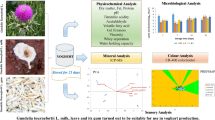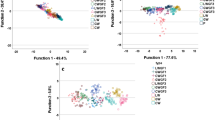Abstract
In the present investigation, the composite flour combinations using whole wheat flour (X1), tapioca flour (X2) and defatted soy flour (X3) for the noodle preparation were made through central composite rotatable design (CCRD). The analyzed responses were bulk density (BD), proximate composition, water uptake ratio (WUR), cooking volume expansion (VE), water absorption capacity (WAC), swelling capacity (SC), gruel solid loss (GSL), and sensory characteristics. A second order quadratic polynomial equation was fitted to the data of all responses for prediction. The maximum protein content of 16 g% was achieved by the combination of 75.54 g of whole wheat flour, 10 g of tapioca flour and 19.78 g of defatted soy flour. Since the inclusion of defatted soy flour >10 g resulted negative influence on good quality determining responses, the Chinese salted noodles of excellent quality with maximum WAC, WUR, VE, SC, protein, carbohydrate, ash and minimum GSL, BD, fat, moisture could be made from ratio of combination of three independent variables at 77.33 g (X1): 22.19 g (X2): 8.92 g (X3) respectively. The cost of production per kg of noodles with optimum level of ingredient was Rs.75.50/-.



Similar content being viewed by others

References
AACC (2000) Approved methods of the AACC (10th ed.), St.Paul, M.N.: American Association of Cereal Chemists. Methods. St.Paul MN, p 1–8
Alpaslan M, Hayta M (2006) The effects of flaxseed, soy and corn flours on the textural and sensory properties of a bakery product. J Food Qual 29(6):617–627
Baik BK, Lee MR (2003) Effects of starch amylose content of wheat on textural properties of white salted noodles. Cereal Chem 80:304–309
Crosbie GB, Ross AS, Moro T, Chiu PC (1999) Starch and protein quality requirements of Japanese alkaline noodles (Ramen). Cereal Chem 76:328–334
Devaraju B, Begum MJ, Begum S, Vidhya K (2006) Effect of temperature on physical properties of pasta from finger millet composite flour. J Food Sci Tech 43(4):341–343
Dick JW, Youngs VL (1988) Evaluation of durum wheat semolina and pasta in the United States. In: Fabriani G, Lintas C (eds) Durum wheat: chemistry and technology. American Association of Cereal Chemists, St.Paul, M.N, pp 237–248
Diwan H, Ahmad A, Iqbal M (2007) Genotypic variation in the phytoremediation potential of Indian mustard against chromium toxicity. Environ Manag 29:473–478
Eyidemir E, Hayta M (2009) The effect of apricot kernel flour incorporation on the physicochemical and sensory properties of noodles. Afr J Biotechnol 8(1):85–90
Ge Y, Sun A, Cai T (2001) Study and development of a defatted wheat germ nutritive noodle. Eur Food Res Technol 212:344–348
Hongsprabhas P, Kamolwan I, Rattanawattanaparkit C (2006) Architectural change of heat mungbean, rice and cassava starch granules: effect of hydrocolloids and protein containing envelop. J Carbohydr Polymer 67:614–622
Hulse JH (1974) The protein enrichment of bread and baked products. In: Altschul A (ed) New protein foods, vol 1A. Academic Press, New York, p 155
Hummel C (1966) Macaroni products: manufacture, processing and temperature. Packing. C. Hummel (ed) Food Trade Press. London
Hundal M, Bakhshi AK, Kaur A (2007) Studies on the preparation of instant fresh spaghetti flavoured with various spices (Ginger, Garlic and Onion). Beverage and Food World. January: 45–48
Nagao S (1996) Pasta and noodle technology. En Kruger JE, Matsuo RB, Dick JW (eds) Processing technology of noodle products in Japan. Am. Assoc. Cereal Chem. St. Paul, MN. p 169–194
Oberoi HS, Kalra KL, Gupta AK, Uppal DS (2007) Effect of cauliflower waste supplementation on glucoamylase production using Aspergillus niger NCIM 1054. J Food Sci Tech 44:509–512
Rachna R, Bhatnagar V, Verma RC (2006) Quality evaluation of soy coffee incorporated baked products. Beverage and Food World 33(8):41–42
Ranganna S (2006) Handbook of analysis and quality control for fruit and vegetable products. Tata McGraw Hill Publishing co. Ltd., New Delhi
Sadasivam S, Manickam A (2005) Biochemical methods. New Age International Private Ltd., New Delhi. Second Edition. p 8–9, 20–21 and 56–57
Shanthi P, John Kennedy Z, Parvathi K, Malathi D, Thangavel K, Raghavan GSV (2005) Studies on wheat based composite flour for pasta products. Indian J Nutr Diet 42:503–506
Sharma A, Yadav BS, Ritika B (2008) Resistant starch: physiological roles and food applications. Food Rev Int 24:193–234
Shittu TA, Dixon A, Awonorin SO, Sanni LO, Maziya-Dixon B (2008) Bread from composite cassava–wheat flour. II: effect of cassava genotype and nitrogen fertilizer on bread quality. Food Res Int 41(6):569–578
Urooj A, Rupashri K, Puttaraj S (2006) Glycemic responses to finger millet based Indian preparations in non-insulin dependent diabetic and healthy subjects. J Food Sci Tech 43(6):620–625
Wang Ch, Kovacs MIP, Fowler DB, Holley R (2004) Effects of protein content and composition on white noodle making quality: Color. Cereal Chem 81:777–784
Williams CP, Nakoul H, Singh KB (1983) Relationship between cooking time and some physical characteristics in chick pea (Cicer arietinum L,). J Agr Food Chem 34:492–496
Wu TP, Kuo WY, Chen MC (1998) Modern noodle based foods-product range and production methods. American Association of Cereal Chemistry, St. Paul. MN, USA, pp 37–89
Author information
Authors and Affiliations
Corresponding author
Rights and permissions
About this article
Cite this article
Vijayakumar, T.P., Boopathy, P. Optimization of ingredients for noodle preparation using response surface methodology. J Food Sci Technol 51, 1501–1508 (2014). https://doi.org/10.1007/s13197-012-0641-z
Revised:
Accepted:
Published:
Issue Date:
DOI: https://doi.org/10.1007/s13197-012-0641-z



